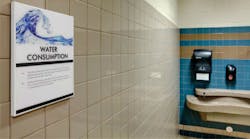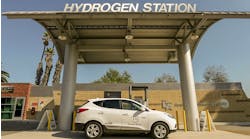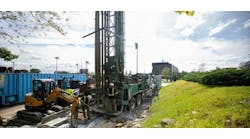Here is an idea … let's spend money on educating children instead of on unnecessary energy costs. Even though there's been a slight reprieve in energy costs, the reality is that the cost of non-renewable energy is increasing, and state education budgets are shrinking.
Recent history tells us that per-pupil funding struggles to keep up with federal and state mandates and learning needs. With the public's expectation that schools do more with less and master the art of pinching pennies, frugal business acumen is the "flavor of the day" in education.
An energy audit
One way to keep energy and operations costs from overshadowing education budgets is to develop a 10-year energy audit plan to eliminate waste. First, facility managers should know the existing energy-use costs for each of their buildings. Gather utility bills for all buildings and have an architect or engineer prepare a "dashboard" that shows dollars per square foot of building area for each utility. From this data, an architect or engineer can assess the energy efficiency in each building.
Conducting an energy audit and calculating effective cost paybacks, which consist of architectural, mechanical and electrical components, is a surefire way to identify "low-hanging fruit," or relatively easy improvements that can be paid for through energy savings. Shorter paybacks result in immediate energy savings; projects with longer payback periods may require phasing or sequencing for completion. The energy audit leads to a long-term energy-efficiency plan that helps institutions determine cost-saving energy improvements.
Behavioral changes
Reducing energy consumption by changing users' behavior can be accomplished through training and awareness. Carrying out operational strategies and enforcing them consistently encourages faculty, students and other user groups to reduce energy consumption in schools.
Geographic location has a role in what energy-saving steps to take, but there are basic universal recommendations. Capital investments and behavioral changes can lower energy costs dramatically. Schools should initiate awareness programs to inform and educate those using facilities about consuming less energy. Users include building maintenance supervisors, custodians, school administrators, faculty, students and community groups.
Some tips that teach behavioral change to user groups:
-
Maintenance personnel:
- Operate energy-management systems effectively.
- Provide optimal settings for HVAC equipment.
- Train to address changes and faculty turnover.
- Inspect fan rooms, boiler rooms and chiller rooms periodically.
- Clean air-handling-unit coils.
- Adopt consistent scheduling for servicing equipment.
-
Administration, faculty, students and community groups:
- Use the building as a teaching tool.
- Turn off lights during non-occupancy.
- Keep vestibule doors closed.
- Use energy-efficient appliances and equipment.
- Be conscious about water conservation.
Capital investments
Most often, priorities for energy-efficiency capital investments are determined by project costs, life-cycle analyses and payback timeframes. The infusion of grants or low-interest loans may shorten the calculated payback period to a point where the project can be financially managed sooner.
Recommendations for facilities upgrades and capital investments that reduce energy costs:
-
Overall design:
- Design for Energy Star rating through the U.S. Environmental Protection Agency.
- Use energy-modeling programming for 40 percent reduction in energy costs.
- Establish energy monitoring and trend-logging of energy usage.
- Proceed with commissioning/re-commissioning.
- Design for energy rebates from utility companies.
-
Site:
- Use plant vegetation that reduces water-source demand.
- Use roof-water collection for irrigation.
- Situate landscaping to shade glazing areas appropriately.
-
Building envelope
- Orient the building in a north/south direction for daylighting.
- Provide clerestory lighting for interior spaces.
- Enhance the thickness and type of roofing insulation.
- Enhance window and glazing systems.
- Enhance the thickness of wall insulation.
- Install continuous air-infiltration barriers.
-
Mechanical systems
- Specify night set-back systems for energy reduction.
- Provide occupancy sensors for ventilation systems.
- Use ice-storage systems.
- Design energy-management systems.
- Reduce AHU (air-handling unit) air leakage.
- Incorporate AHU economizer optimization.
- Provide AHU outside-air reduction (including carbon-dioxide control).
- Reduce AHU run-time (including optimum start/stop).
- Adjust/reset AHU supply-air static pressure.
- Provide AHU supply-air temperature reset.
- Adjust/reset chiller water supply temperature set-points.
- Adjust/reset condenser water supply temperature set-points.
- Eliminate simultaneous or wasted heating and cooling.
- Provide heating water supply temperature adjustment/reset.
- Incorporate unoccupied setbacks.
- Establish refrigeration management.
- Design for energy recovery and thermal energy storage.
- Specify variable-frequency drives.
- Use renewable-energy sources.
- Design central positive-displacement systems.
- Design thermal energy storage (TES) systems for off-peak demand-energy reduction.
- Design geothermal systems.
- Capture preconditioned air for natatorium energy recovery and dehumidification.
- Use low-water-flow plumbing systems.
-
Electrical systems
- Design high-efficiency lighting.
- Incorporate occupancy sensors into lighting systems.
- Reduce lighting and equipment run-time.
- Provide electric water-cooled chillers.
- Incorporate LED lighting.
- Provide light-colored finishes for reflectance.
- Specify multiple-level lighting capability.
Measuring effectiveness
Once energy-efficiency investments are made, how is energy effectiveness verified? Begin by monitoring building energy use. By maintaining an energy-use "dashboard" that documents heating use (therms), domestic use (therms), electric use (kilowatt hours/demand), and water/sewage/storm use (k gallons), one can observe monthly total gas, electric and water costs and the total kBTU per year per square foot in comparison with the total heating and cooling degree days. If the results show a reduction in energy use, that's a clear sign the plan is working. The next step is to engage in commissioning services to provide verification and authentication of energy-efficiency programs and investments.
Much can be done to improve energy efficiency, from the basics of tracking utility bills to detailed operations and maintenance strategies. Saving energy can be fun; schools should be tools for students to learn about resource conservation by observing how the school itself reflects high-performance design. Through interactive activities and awareness campaigns, students and faculty can participate in saving energy, and become part of the effort to make a difference in their education and environment.
Improved energy efficiency enables more dollars to flow into the classroom. Action is required; schools throughout the nation are getting their energy usage in order so that more money can be used for educating learners and supporting the community.
- Read the "Energy-saving measures" sidebar to learn how Osseo (Minn.) Area Public Schools is improving energy efficiency in its facilities.
Erickson, AIA/NCARB/REFP, is president of ATS&R Planners/Architects/Engineers, Minneapolis, a multi-disciplined firm specializing in pre-K to 12 and post-secondary school planning and design. He can be reached at [email protected].


